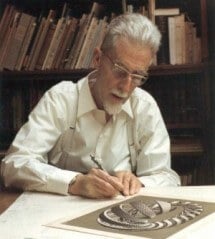M.C. Escher

1898–1972
The Dutch artist Maurits Cornelis Escher—better known to the world as M.C. Escher—was a draftsman, book illustrator, tapestry designer and muralist, but his primary work was as a print-maker. The main subjects of Escher’s early art are Rome and the Italian countryside. While living in Italy from 1922 to 1935, he spent the spring and summer months traveling throughout the country to make drawings. Later, in his studio in Rome, Escher developed these into prints.
Whether depicting the winding roads of the Italian countryside, the dense architecture of small hillside towns, or details of massive buildings in Rome, Escher often created enigmatic spatial effects. These effects were created by combining various—often conflicting—vantage points, for instance, looking up and down at the same time. He frequently made such effects more dramatic through his treatment of light, using vivid contrasts of black and white.
After Escher left Italy in 1935, his interest shifted from landscape to something he described as “mental imagery,” often based on theoretical premises. This was prompted in part by a second visit in 1936 to the 14th century palace of the Alhambra in Granada, Spain. The lavish tile work adorning the Moorish architecture suggested new directions in the use of color and the flattened patterning of interlocking forms. Replacing the abstract patterns of Moorish tiles with recognizable figures, Escher developed “the regular division of the plane” in the late 1930s. The artist also used this concept in creating his Metamorphosis prints. Starting in the 1920s, the idea of “metamorphosis”—one shape or object turning into something completely different—became one of Escher’s favorite themes. After 1935, Escher also increasingly explored complex architectural mazes involving perspective games and the representation of impossible spaces.
Since 1964, the National Gallery of Art has formed the preeminent collection of Escher’s art outside of Holland through the generosity of many donors, including Cornelius Van S. Roosevelt and Lessing J. Rosenwald, both of whom knew Escher. The Gallery’s collection includes more than 400 works by Escher: drawings, illustrated books, technical materials and impressions of 330 of the artist’s 450 prints.
During his lifetime, Escher made over 400 woodcuts, wood engravings and lithographs, and more than 2,000 drawings and sketches. He died on March 27, 1972 at the age of 73.


